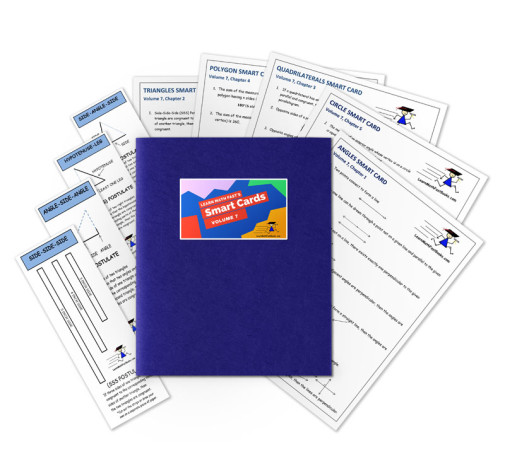We use cookies to make your experience better. To comply with the new e-Privacy directive, we need to ask for your consent to set the cookies. Learn more.
Learn Math Fast Smart Cards for Volume 7
Covers all postulates and theorems taught in Volume 7.
These five Smart Cards contain dozens of helpful reminders for High School Geometry. They go perfectly with the Learn Math Fast System Volume 7 (sold separately). The Smart Cards are printed on 8 ½" x 11" sheets of card stock with color ink on front and back. High School Geometry teaches a lot of Theorems and Postulates. These five cards have simplified and organized them into five categories. The five categories correspond to the five chapters in volume 7 of the Learn Math Fast System (sold separately), but could pair up nicely with any other Geometry curriculum as well. The categories are: Angels, Triangles, Quadrilaterals, Polygons, and Circles. There are four Postulate Cards too. These are smaller cards, printed on one side only. Each one is to help students remember the SAS, HY-LEG, SSS, and ASA Postulates.
Looking for a streamlined curriculum with targeted goals spanning from beginning math (starting with the concepts of addition) to high school Algebra and Geometry? This curriculum’s title “fast” highlights this 7-volume 2nd edition goal: to develop students who can quickly produce automatic, confident responses to math problems. Topically arranged, this mastery-based program presents math concepts in a sequential manner. Each of these un-graded levels teaches multiple concepts and can be used by multiple ages as a supplement or stand-alone for those students who need to shore up math skills. The series can also help struggling learners who may be behind in levels. Math “tricks” are taught to help students grasp skills quickly. No matter your student’s grade, the author recommends starting at Level 1. Free placement tests, however, are available in PDF. Level 1 contains instruction pages for using the overall program with different aged learners. As a more self-directed program, no teacher guide is available; answers and detailed solutions (which vary based on level) are included in the back of each book.
Each softcover book (ranging from 148-348 pgs, pb.) includes detailed lessons written to the student in a conversational—and sometimes humorous—style at a 3rd-4th grade reading level. Each consumable level provides worksheets within the text. Additional worksheets are available at the publisher’s website as free downloads. At the lower levels, topics are introduced using a few different methods including tips and shortcuts, using U.S. coins as manipulatives. Concepts are taught, a practice worksheet follows, and then there is a timed test. Students practice concepts with worksheets (either in convenient preprinted form in Level 1 or PDF printables) until they are confident in the concept, able to complete the test and then move on to the next lesson. At higher levels, students are taught the concept and complete a worksheet, with the possibility of repeated practice. Each level includes chapter tests and a final review test and access to printing extra PDF worksheets. The first 4 volumes cover pre-high school skills. Volume 1 overviews math facts. Purchase this text separately (and download extra PDF worksheets free) or purchase with the preprinted worksheets and answer key (LMF1WS). Volume 2 teaches fractions and percentages; Volume 3 overviews prealgebra skills; and Volume 4 covers basic Geometry. The last 3 volumes overview high school math. Volume 5 equates to Algebra 1; Volume 6 to Algebra 2; and Volume 7 completes the program with Geometry.
A few atypical manipulatives are needed. These are available separately or packaged with the appropriate volume. For Volume 1, you may want a handful of coins for your hands-on learners. The program utilizes the 8.5”x11” Big, Big Bookmark printed with foundational math skill tips and serves as a reference guide for all levels. Level 4 (Beginning Geometry) requires a manipulative kit that can be purchased separately. The Geometry Kit (contained in a zippered, 3-hole punched vinyl zippered pouch) is a simple set that includes 15 1-inch foam squares; a 1-inch plastic ball; protractor and two kinesthetic cards which help teach Pi; a square foot paper; a formula card; a square; rectangle; and one each of an equilateral, right triangle, and isosceles triangle cards with helpful reminders printed on one side. Level 7 requires “smart cards” (four 3”x 6 ½” postulate cards), and larger format smart cards which succinctly include all postulates and theorems for angles, triangles, quadrilaterals, polygons, and circles.
For classroom or small-group teachers, digital
options of the extra worksheets are available. These are not available for
homeschool use, since extra worksheets are available free with book purchase. These
Digital Classroom Licenses allow printing licenses for Levels
1-4 via PDF. THESE LICENSES ARE NOT THE COMPLETE COURSE IN DIGITAL FORM.
Select between licenses for 1, 5, or 10 students. Purchase multiple licenses to
equal the number of students in your classroom. Alongside the digital license,
you’ll need the Learn Math Fast Teacher’s Pack (which includes the first
4 volumes; the Big, Big Bookmark; and the Basic Geometry Kit). ~ Ruth

















A quick reference card is always helpful.